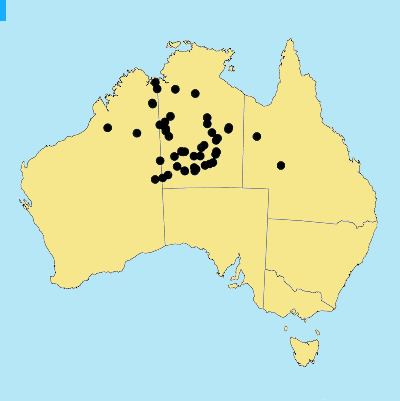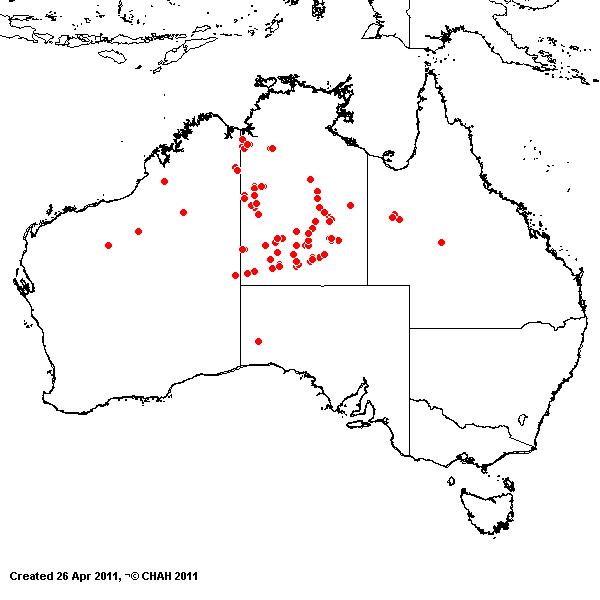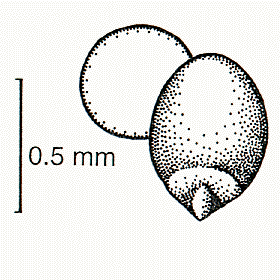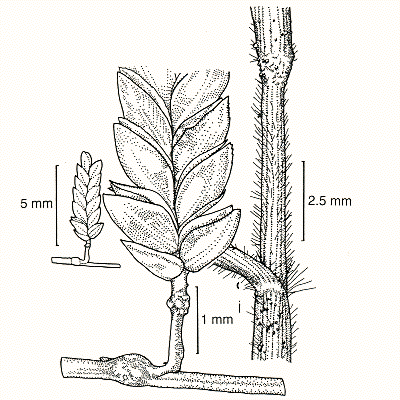Eragrostis olida M. Lazarides.
Aust. Syst.
Bot. 10: 137
(1997).
Classification. (GPWG 2001) : Subfamily
Chloridoideae. Cynodonteae.
Type of Basionym or
Protologue Information: Australia,
Queensland, Mt. Isa:
Schmid 88 (CANB holo, BRI).
Key references
(books and floras): [2002] D.Sharp & B.K.Simon, AusGrass, Grasses of
Australia.
Illustrations:
[2005] K.Mallet (ed.), Flora of Australia 44B: Poaceae 3
(Fig. 66A, Fig. 68R-T).
Habit.
Perennial. Culms erect, 17–50 cm tall, wiry, 6–10(–20) -noded. Mid-culm
internodes hirsute or hispid. Mid-culm nodes glabrous or bearded. Lateral
branches branched. Leaf-sheaths hairy. Ligule a fringe of hairs, 0.5–1 mm long.
Leaf-blades straight, flat or involute, 1–2(–8) cm long, 1–2 mm wide.
Leaf-blade surface indumented.
Inflorescence.
Inflorescence compound, a panicle. Panicle ovate, 8–15 cm long, 4–8 cm wide.
Spikelets.
Spikelets pedicelled. Fertile spikelets many flowered, with at least 2 fertile
florets (9–66), comprising 9–66 fertile floret(s), with diminished florets at
the apex, linear or oblong, laterally compressed, 4–30 mm long.
Glumes. Glumes
similar. Lower glume ovate, membranous or cartilaginous, much thinner on
margins, keeled, 1-keeled, 1 -nerved. Lower glume apex muticous or mucronate.
Upper glume ovate, 0.8–1.8 mm long, membranous or cartilaginous, keeled,
1-keeled, 1 -nerved. Upper glume surface smooth or asperulous.
Florets.
Fertile lemma 1.8–2 mm long, keeled, 3 -nerved. Lemma apex muticous or
mucronate. Palea 2 -nerved. Anthers 2–3. Grain 0.6–0.8 mm long.
Continental
Distribution: Australasia.
Australian
Distribution: Western Australia, Northern Territory, Queensland.
Western Australia: Hall, Dampier.
Mueller, Canning. Northern Territory: Darwin & Gulf, Victoria River,
Barkly Tableland, Central Australia North. Queensland:
Burke.
Notes.
Distinguishing characters include the presence of glands, prickly tubercles and
curved or hooked spinules on many parts of the plant; thickened spinulose palea
keels protruding beyond margins of lemma; turgid stipitate caryopsis; branched
yellow stigmas; panicle divisions with exuding resinous bands and glandular
tipped hairs; overlapping leaf sheaths; pungent blades; viscid odorous habit,
and bulbous hirsute rootbase.
Endemic;
occurs in the Great Sandy Desert and the NE Kimberley, W.A., common throughout
central N.T., and only known from Mt Isa, Qld. In skeletal, stony or rocky
soils on the slopes, crests, and crevices of hills, outcrops, mesas, gorges and
ridges of sandstone, quartzite and laterite.; flowers all year round.; fruits
all year round.







